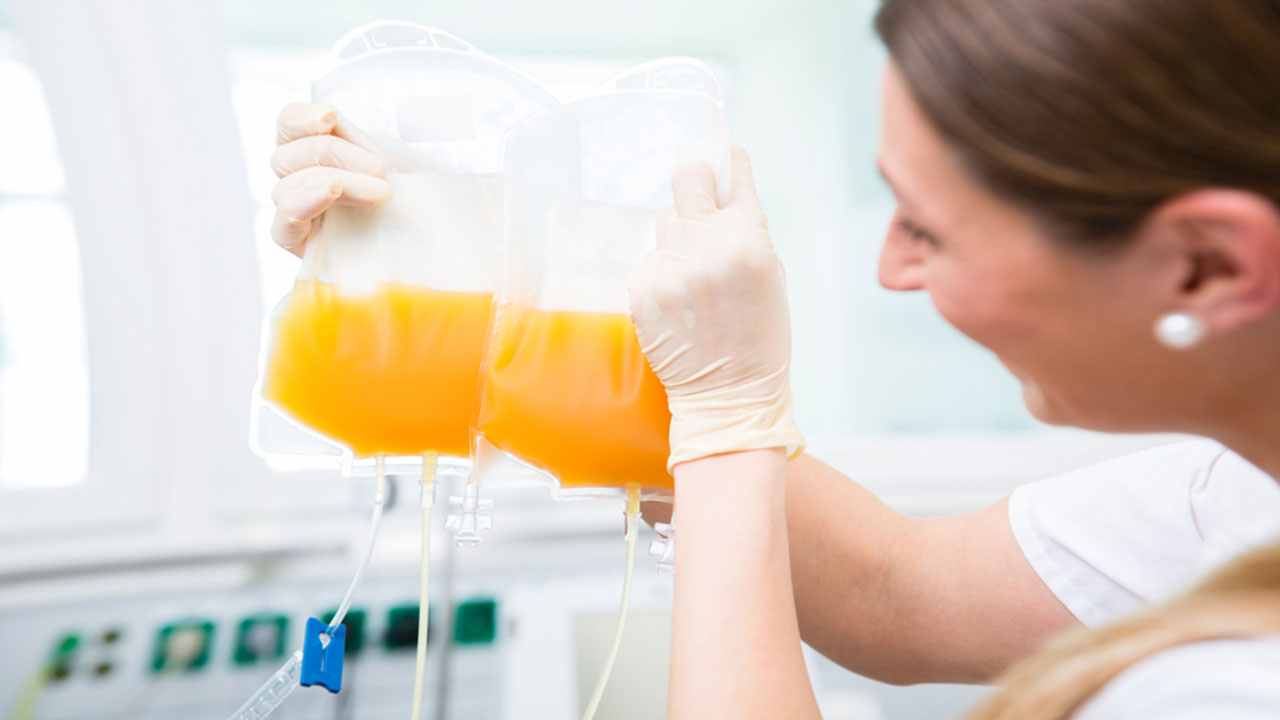Is Donating Plasma Safe? The Risks and Rewards of Plasma Donation
 By: by Amino Science
By: by Amino Science

Many people are familiar with annual drives to get blood donations, but what are the extra steps involved in plasma donations? Find out why people become plasma donors, what donated plasma is used for in hospitals and treatment facilities, and most importantly: is donating plasma safe enough for you?
Why Donate Plasma?
Donating plasma is often referred to as giving "the gift of life." A plasma transfusion can help save lives that would otherwise be lost and help treat chronic rare diseases that have no other alternative or cure. Plasma donation is also the gift that gives back.
Because the plasma collection process is longer and takes more out of you than the normal whole blood donation process, you are paid for your time. Donors are paid for the amount of plasma they can donate, and usually the larger the donor, the more plasma they can supply. The United States Food and Drug Administration (FDA) recognizes the following categories of plasma donors based on weight.
- Between 110 and 149 pounds
- Between 150 and 174 pounds
- Above 175 and up to 400 pounds
Payments range between $20 and $50 per donation (rates depend on the company operating the plasma center), and you are allowed to donate 2 times within a 7-day period, so long as you allow at least 48 hours between donations. Assuming you're healthy enough, that means you could donate 2 or 3 times a week for a month and make hundreds of dollars for your time.
For those in good health, donating the plasma proteins in your blood can be an easy way to make extra cash and provide important biological material for life-saving treatments. Read on to learn how your plasma is used, what the donation process entails, and some tips for safety and comfort as you donate.

What Is Plasma Used For?
The following components make plasma uniquely suited for specific medical treatments.
- Albumin: Albumin is used to treat surgical patients, trauma cases, and burn survivors. Albumin is a protein synthesized by the liver that helps retain fluid in your bloodstream. It reduces edema formation around damaged tissue and replaces the loss of blood volume sustained during injury or surgery.
- Alpha-1 antitrypsin (AAT): Commonly referred to as genetic emphysema, alpha-1 antitrypsin deficiency occurs in individuals who have inherited abnormal AAT genes from both biological parents, which leads to a lack of the AAT protein. The AAT protein functions to protect the lungs from inflammation caused by environmental fumes (including cigarette smoke) and infections. Without it, alpha-1 patients are more likely to develop serious lung and/or liver diseases. An infusion of plasma-derived AAT can save their lives.
- Clotting factors: Those with bleeding disorders such as hemophilia are unable to clot blood effectively. Minor injuries that would cause minimal bruising for healthy individuals could cause internal bleeding, critical organ damage, and death in those without enough clotting factors. Clotting factors are among the proteins donated via plasma.
- Immunoglobulin (IVIG): Individuals with primary immune deficiency disorders (PIDs) do not respond normally to regular antibiotics and require donated IVIG to help prevent infections and to treat immunodeficiency disorders like B-cell chronic lymphocytic leukemia and inflammatory demyelinating disorders. IVIG may also help treat myasthenia gravis, Guillain-Barré syndrome, and multiple sclerosis, though research is still ongoing.
- Hyperimmune globulins: Donated hyperimmune globulins are used to create vaccine alternatives that provide "passive" immunity instead of "active" immunity. Active immunity occurs when the antigens from certain pathogens are introduced to a healthy immune system, which prompts the creation of targeted antibodies. Immunizations created using donated resistance cells can help treat pregnant women whose unborn child has an incompatible blood type, as well as those with compromised immune systems such as organ transplant or dialysis patients. Hyperimmune globulins are available for tetanus, rabies, hepatitis B and more, but these injections are often painful and carry the risk of anaphylaxis, so are only used when medically necessary.
When you donate plasma, you contribute to these vital treatments.

The Plasma Donation Process
The process of separating plasma from other blood components including red blood cells and white blood cells is known as plasmapheresis. Here's what to expect if you're a first-time donor.
- Check-in: Upon arrival at the plasma donation center, you'll be greeted and asked for proof of ID, current address, and citizenship. You'll answer questions about your medical history to determine your eligibility to donate (this information is confidential).
- Screening process: A medical examination follows, which may include taking your temperature, your pulse, and checking your blood pressure.
- Donation: If you're deemed to be in good health, a phlebotomist will escort you to a donation chair and hook you up to a plasmapheresis machine. Your blood is drawn from one arm, processed to extract the relevant plasma material, and returned via the other arm with the addition of saline to replace the blood volume extracted.
- Duration: The process of filtering your blood takes about an hour and a half. Bring a novel, a book of Sudoku puzzles or Crosswords, or an electronic device and a portable charger to while away the time pleasantly.
- Reward: Once your donation is complete, you'll be compensated for your time and generosity with a prepaid debit card. Because it often takes at least 2 donations to collect enough useful material, many plasma donation centers pay larger sums if you visit them regularly. Each visit requires less screening time, provides the center with more usable material, and rewards you with more money and bonuses.

Is Donating Plasma Safe? Possible Risks and Wellness Tips
Donating plasma is often a win-win situation: you're providing life-saving antibodies and proteins, plus you're making a little extra money to spend as you see fit. However, donating blood plasma does come with certain potential side effects. Be aware of the following risks, and follow these tips to safeguard your health.
Protein Replacement with Amino Acids
Like all protein synthesized in the body, plasma proteins are created from amino acids. When you donate those proteins via your plasma, your body immediately gets to work replacing them. Without a sufficient amount of the nine essential amino acids, your body may start harvesting healthy muscle cells to replace what was donated, a process known as catabolism.
Tip: Before donating, take a comprehensive amino acid supplement such as Life or Heal to make sure you've got the supplies to recreate your plasma proteins quickly. This is especially important if you plan on donating multiple times throughout the week or month, as your body will have to continuously replace these proteins. It's also recommended that you eat a healthy meal within two hours before donating, one that includes either plant or animal protein for extra dietary amino acid support.
Fatigue, Dehydration, and Dizziness
Mild fatigue, dehydration, lightheadedness, and sometimes fainting are common side effects experienced by both plasma and blood donors. When the body is low on water, salts, and other blood-borne nutrients found in plasma, you may experience a noticeable lack of energy throughout the rest of the day accompanied by unpleasant dizziness and feelings of thirst.
Tip: Bring along a sports drink with salts and electrolytes to help replenish your body, drink plenty of water, and avoid strenuous activity or exercise for at least 24 hours. Basically, if you're going to hit the gym, do so in the morning before you donate, and be sure to stay hydrated throughout.
Bruising and Pain
Bruising and tenderness at the injection sites is another common side effect of plasma donation. Bruising is caused by blood pooling in the soft tissues outside of your veins and arteries, so along with the discomfort associated with being stuck by a needle, if a small amount of blood leaks out during the procedure, you may bruise. This is normal, and no real cause for concern unless you have a bleeding disorder.
Tip: While bruising and pain heal on their own, you can help by keeping the bandages applied by the phlebotomist on for at least 6 hours and avoiding heavy lifting for a few days so as not to aggravate the injury.
Infection
Plasma donation centers are highly controlled sterile medical environments, but any time a needle punctures your skin there is some risk of infection. To minimize the risk that bacteria on the skin's surface could enter the body, practitioners swab and sanitize the area first, open a clean needle, and wear gloves, but preventing infection is never a 100% guarantee.
Tip: When it comes to avoiding possible infection at the puncture site, it's recommended that you only donate when you're perfectly healthy, as any common cold or flu compromises your immune system and makes you more susceptible to other opportunistic infections. You may also supplement with natural immunity aids and antioxidants like vitamin C for an extra boost.
Another way to protect yourself is to know the signs of infection: if the injection site becomes swollen, reddens, or begins to feel warm and tender, it may be an immune response to bacteria, and it's recommended you see a doctor right away to prevent any complications (you may be prescribed antibiotics). Infections from plasma donation are rare, but while they're possible it's important that you know how to deal with them safely.
Arterial Puncture
Another possible side effect of any needle injection or insertion is an arterial puncture. Arteries have a higher blood pressure than veins do, so should the technician miss your vein and puncture an artery instead, it could lead to excessive bleeding.
Tip: Alert your technician if something feels amiss with your puncture so they can quickly remove the needle and apply sustained pressure to the area (at least 10 minutes). Usually, this allows your blood to clot and the injury to begin to heal, but in the rare circumstances in which there is continued bleeding, the technicians at the plasma center will get you emergency care right away.
Citrate Reaction
Citrate reaction is an extremely rare but incredibly serious potential side effect of donating plasma. Citrate is an anticoagulant used during the plasmapheresis process to keep your blood from clotting before it can be safely returned to your body. Most of the citrate remains in the machine, but some of it inevitably enters your bloodstream.
Citrate temporarily bonds with your calcium molecules, and while most people do not experience any noticeable reaction to citrate, that loss of calcium can bring about the following side effects of citrate reaction in others.
- A metallic taste
- Shivering or chills
- Tingling in the fingers, lips, and toes
- Lightheadedness
- Shortness of breath
- Abnormal pulse (too fast or too slow)
- Muscle twitches or feelings of vibrations in the body
If left untreated these side effects could lead to spasms, vomiting, a state of shock, or cardiac arrest.
Tip: If you experience any of these irregular symptoms, seek professional medical care immediately.

The Gift of Life
Plasma donation is highly rewarding in more ways than one: it can help you out financially and literally save the life of a stranger. However, it's important to preserve your health as you're sharing it, so while the FDA guidelines say you can donate multiple times per month, the American Red Cross recommends donating plasma no more than 13 times per year for optimum health. Keep track of how often you donate and be sure to listen to your body so you don't endanger your own good health while you give the gift of life.

Up to 25% off Amino
Shop NowTAGS: conditions
Join the Community
Comments (0)
Most Craveable Recipes




 833-264-6620
833-264-6620



















